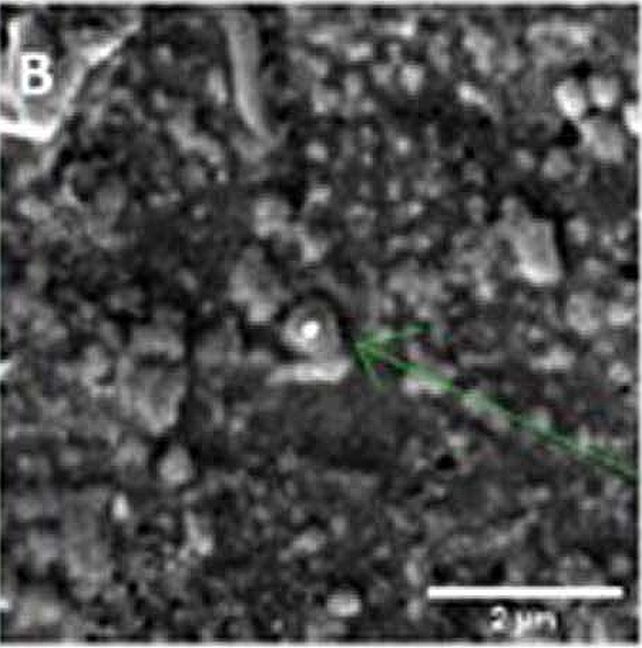ARTICLE AD
 An artist's impression of a supernova. (Science Photo Library - MEHAU KULYK/Brand X Images/Getty)
An artist's impression of a supernova. (Science Photo Library - MEHAU KULYK/Brand X Images/Getty)
A grain of dust recovered from an ancient meteorite that plonked itself down in Antarctica appears to be from a rather unusual place in space and time.
It's a tiny speck of a mineral called olivine, and its isotope composition is so alien that it could only have been produced by another star, dying before the Solar System was even born. Known as presolar grains, the rare motes are highly prized for what they can tell us about different stellar environments in the galaxy and the worlds that may form therein.
Unfortunately they are hard to identify. They're very small, averaging just 150 nanometers in size, and usually deeply embedded in meteorite rock.
A team led by astrogeologist Nicole Nevill of the Lunar and Planetary Institute in Houston discovered the olivine presolar grain in the Antarctic meteorite using a technique called atom probe tomography, and it's smashing records that reveal a fascinating history.
"Material created in our Solar System have predictable ratios of isotopes – variants of elements with different numbers of neutrons. The particle that we analyzed has a ratio of magnesium isotopes that is distinct from anything in our Solar System," Nevill says, who analyzed the grain as part of her PhD studies at Curtin University in Perth, Australia.
"The results were literally off the charts," she continues. "The most extreme magnesium isotopic ratio from previous studies of presolar grains was about 1,200. The grain in our study has a value of 3,025, which is the highest ever discovered. This exceptionally high isotopic ratio can only be explained by formation in a recently discovered type of star – a hydrogen burning supernova."
Meteorites are rocks that have fallen to Earth from beyond our atmospheric borders; little pieces of the cosmos that come to us. They give us a little time capsule of when they formed, as well as detailed information about the composition of dust from which they formed.
By and large, they are chunks of our own Solar System, consisting of pieces of rock that may have formed very early in the Solar System's history or chunks of other planets.
 The tiny grain. (Nevill et al., ApJ, 2024)
The tiny grain. (Nevill et al., ApJ, 2024)Every now and again, though, scientists have been able to identify a grain of something that didn't form so close to home. Such prizes are eagerly sought for what they can tell us about space outside the solar environment.
Nevill and her colleagues found their presolar grain in a meteorite called Allan Hills 77307, found in Antarctica back in the late 1970s. This meteorite is classified as a carbonaceous chondrite – a piece of carbon-rich rock that formed in the very early days of the Solar System and subsequently spent billions of years just hanging out in space as an asteroid.
Olivine, a silicate of magnesium and iron, is fairly common both on Earth and in extraterrestrial contexts, but its isotope composition varies depending on where it was formed. Some presolar grains can be identified based on the ratios of isotopes of magnesium; the signature relevant to ALH 77307 is a particularly high ratio of magnesium-25.
When Nevill and her colleagues used atom probe tomography on the speck of olivine, measuring just 400 by 580 nanometers (that's around 170 times smaller than the width of a human hair), they discovered that it contained a higher proportion of magnesium-25 than any sample ever measured – far higher than anything that could be produced within the Solar System.
Models suggest, in fact, that the observed ratio was most likely to be produced in a sort of violent event the Solar System hasn't (and hopefully never will) experienced – a supernova, the explosive death of a massive star. Then the grain just hung around until the Solar System arrived, and it got bound up in AH 77307.
"The atom probe has given us a whole level of detail that we haven't been able to access in previous studies," says physicist and geochemist David Saxey of Curtin University in Australia.
"Hydrogen burning supernova is a type of star that has only been discovered recently, around the same time as we were analyzing the tiny dust particle. The use of the atom probe in this study gives a new level of detail helping us understand how these stars formed."
That, however, will be another work, for another time. For now, we'll just have to marvel at how adept scientists are becoming at finding, and analyzing, the needle in the meteorite haystack.
The research has been published in The Astrophysical Journal.

 9 months ago
68
9 months ago
68 

